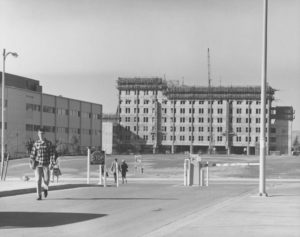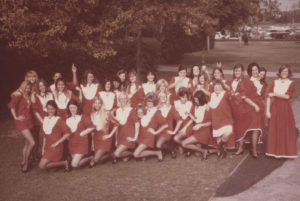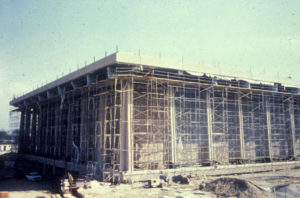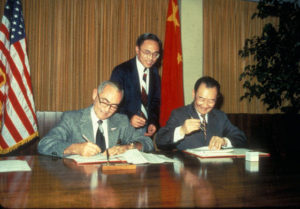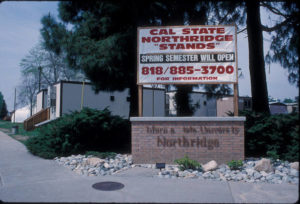Editor’s Note: This narrative highlights a majority of the campus’s milestones over the last 60 years. It is not intended to be an all-inclusive history. While every effort has been made to research and fact check the following information using the resources available, please report any inaccuracies to the catalog editor.
1950s—The Early Years
In fall 1956, the San Fernando Valley campus of the Los Angeles State College of Applied Arts and Sciences was established on the present site of California State University, Northridge. Soon afterward, the California Legislature passed Assembly Bill No. 971, which decreed that the campus would separate from its parent college on July 1, 1958—the founding date of the present
University—to become San Fernando Valley State College. At that time, Dr. Ralph Prator was named the first president, and the campus had an enrollment of approximately 3,300 students and 104 faculty. The first commencement ceremony was held in 1959, graduating 90 students.
The 1950s introduced some of the first campus staples. In February 1957, the student newspaper was established, but it did not have a name until the third issue, when it became State Standard. With the fifth issue, the newspaper was renamed The Sundial and has been known by that name since. In 1958, a student vote established the Matador as the mascot for San Fernando Valley State College, as well as the traditional campus colors of red, white and black. In 1959, the College constructed the first permanent building on campus—the former South Library.
1960s—Continuing Development
In the 1960s, San Fernando Valley State College evolved from a collection of temporary buildings into a true college campus. The original Fine Arts Building, designed by prominent Southern California modernist architect Richard Neutra, was completed at the start of the decade. The building, destroyed in the 1994 Northridge earthquake, was replaced by Manzanita Hall in 2003. Monterey Hall was also completed in 1960. Once the Residence Hall, the building has since housed Education faculty and offices for the Department of Communication Disorders and Sciences and the Center for Community Services. The last major development of 1960 was the formal creation of the Alumni Association, which has remained in operation since its inception.
In November 1963, a donation from a local FM station enabled the campus radio station to begin broadcasting as KEDC-FM from the Speech-Drama Building (now Nordhoff Hall). The station, now known as KCSN, has since grown to become an independent public radio station, broadcasting from a studio in the Valley Performing Arts Center. In 1964, the campus completed construction of the Physical Education Building (now Redwood Hall), the Sierra Hall complex, the Administration Building (now Bayramian Hall) and the Engineering Building (now Jacaranda Hall).
That same year, the National Leadership Training Program (NLTP) admitted its first two Deaf students. The program provided them with interpreters and notetakers to ensure that they had full access to university classes, efforts that proved pivotal in the eventual formation of the National Center on Deafness.
In 1966, the legend of Dorothea “Granny” Heitz (B.A. Sociology) began when the 50-year-old enrolled at San Fernando Valley State College. During her time at the University, and long after graduation, Heitz served as the spirit squad leader of the “Granny Girls,” unofficial campus ambassadors who attended sporting, homecoming and other events. Heitz continued as an active volunteer within the campus community and the San Fernando Valley until she passed away in 2007. Today, the Dorothea “Granny” Heitz Award for Outstanding Volunteer Leadership honors her legacy.
The campus carillon was installed in the former Administration Building in 1966, funded by donations from that year’s graduating class. A year later, alumnus Richard Kaufman (B.A. Music) composed the alma mater, “Hail to the Matadors,” performed for the first time during the 1967 Homecoming football game. The fight song is routinely performed at athletic events, Commencement and campus celebrations, and chimes on the carillon daily.
In November 1968, the Black Student Union led a protest that emerged out of frustration with the small number of minority students on campus and inadequate support for low-income students. After months of conflict, the protestors and campus administration reached a compromise to improve diversity among the student body and increase support services. In April 1969, the California Legislature passed Senate Bill 1072, the Harmer Bill, which officially established the statewide Educational Opportunity Program (EOP), facilitating access, support and retention for first-generation, historically low-income and educationally disadvantaged students. The University’s efforts commenced the previous year, by recruiting students and offering the first Summer Bridge program. Over time, the campus’s Educational Opportunity Program has expanded to include the Faculty Mentor Program, the Resilient Scholars Program and several Transitional Programs. In fall 1969, Dr. James Cleary was named the second president, and the campus introduced its first two ethnic studies departments, Mexican-American Studies (now Chicana and Chicano Studies) and Afro-African Studies (now Africana Studies).
1970s—Developing National Recognition
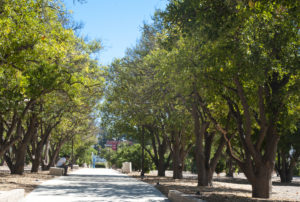
CSUN Orange Grove (Photograph by Lee Choo)
By the dawn of the 1970s, San Fernando Valley State College had established a solid foundation and began honing an identity that would be recognized both regionally and nationally. In 1970, the Volunteer Income Tax Assistance (VITA) Clinic was founded to aid low-income individuals with no-cost tax preparation services, while providing experiential learning opportunities for students. The program was the first university tax preparation service available in Southern California, and VITA continues to operate as a self-funded program with support from community stakeholders.
On June 1, 1972, San Fernando Valley State College was renamed California State University, Northridge, by action of the Legislature and the Board of Trustees of the California State University. That same year saw two other significant events. The first was the Associated Students’ declaration of the campus Orange Grove, the oldest remnant of the San Fernando Valley’s agricultural past, as a historical site.

CSUN Sculpture (Photograph by David Hawkins)
The second was the establishment of the Center on Deafness, renamed the National Center on Deafness (NCOD) in 1978 due to the national impact of the Center’s students and alumni. The Center developed the first postsecondary program in the nation to provide paid sign language interpreters for Deaf students and has since grown to become one of the largest service providers to Deaf students in the western United States.
In spring 1973, a campus-wide competition was held to replace the University’s wooden sign at the corner of Nordhoff Street and Zelzah Avenue. Art department faculty and the Campus Planning Board selected an abstract structure designed by alumnus John T. Banks (B.A., M.A. Art). Dedicated in April 1975, the iconic sculpture remains prominently displayed in the same location today.
October 1973 marked the formal dedication of Phase I of CSUN’s Oviatt Library, named in posthumous honor of the first Dean of Instruction, Delmar T. Oviatt. Phase II, the addition of the east and west wings, was dedicated in 1991. Designed by architect Leo A. Daly, the library is one of the most prominent structures on campus and has made a significant mark in pop culture. First featured in the 1970s television series Medical Center, it has since been showcased by motion pictures such as Sky High (2004), Star Trek (2009) and We are Your Friends (2014), among others. With its variety of architecture and proximity to Hollywood, the campus continues to be a popular filming location.
The San Fernando Observatory, built by the Aerospace Corporation in the 1960s and gifted to CSUN in 1976, has the longest record of any Earth-based observatory for tracking solar activities. Through this resource, hundreds of students and faculty have collected and analyzed solar data. In 2016, the observatory, one of only a dozen in the country, was relocated from San Fernando’s northern Metropolitan Water District in Sylmar to the CSUN campus.
Additional buildings were constructed on the east side of campus in the 1970s to house student services. The Klotz Student Health Center, dedicated in 1976, was named for Dr. Addie L. Klotz, who served as Health Services Director from 1961 to 1972. Under her leadership, the Student Health Center in 1966 became the first such service in the nation to be accredited by the American College Health Association. The University Student Center (later renamed the University Student Union), financed completely by student funding, opened in 1977 to replace the Temporary Union Building, colloquially known as “The TUB.” The facility was designed to enhance the university experience with expanded student services as well as opportunities for employment and campus involvement.
The decade concluded with the expansion of academic programs in the College of Humanities. In 1977, Women’s Studies was approved as an interdisciplinary minor; it would later evolve to become an undergraduate major with a dedicated academic department (now known as Gender and Women’s Studies). The following year, CSUN unveiled the first master’s program in Mexican-American Studies (now Chicano and Chicana Studies).
1980s—The Beginning of International Expansion
In 1980, CSUN history professor Dr. Julian Nava was named the U.S. Ambassador to Mexico by President Jimmy Carter, making him the first Latino to serve in that post. During Dr. Nava’s tenure as ambassador, 10,000 Spanish-language books were donated to CSUN by Mexico’s secretary general in his honor. Later that year, the first seismograph in the San Fernando Valley was installed on CSUN’s campus. While no longer in service, the instrument remains on display in Live Oak Hall.
In 1981, President Cleary led a CSUN delegation of professors and administrators to China to establish faculty and student exchange programs and sign CSUN’s first foreign exchange agreement. By 1992, early agreements had expanded to include schools in Japan, Ukraine, South Korea, Brazil, Taiwan and the Netherlands. In 1982, the University established the China Institute to help facilitate and coordinate CSUN’s cultural and academic activities with Chinese institutions.
In 1983, University faculty approved the creation of the Center on Disabilities, which sponsors international training programs for professionals working in the field of disability. The Center is responsible for the largest and longest-running university-sponsored annual International Technology and Persons with Disabilities Conference. In 1986, the groundbreaking ceremony for the new National Center on Deafness site took place. Completed in 1989, the building was named Jeanne M. Chisholm Hall by donor Grace Petri in memory of her sister. That same year marked the groundbreaking ceremony for University Park, constructed on CSUN’s North Campus to provide further on-campus dormitory options for the growing student population.
1990s—Perseverance and Reconstruction
CSUN dedicated an addition to the Science Buildings, including an on-campus planetarium, in 1990, giving the University the only complete astronomical facility in the CSU system. The planetarium was later posthumously named in memory of the founding College of Science and Mathematics dean, Donald E. Bianchi. That same year, the Oviatt Library installed the Automated Storage and Retrieval System (ASRS), the first of its kind in the nation. The ASRS can house and expediently retrieve up to 1.7 million volumes. Also in 1990, the Marilyn Magaram Center for Food Science, Nutrition and Dietetics was dedicated to honor its namesake’s legacy as a prominent dietitian, along with her contributions to modernize the Family and Consumer Sciences department’s research science lab equipment during her time as a graduate student at CSUN. At the time of its construction, it was the only facility of its kind in the CSU system. In 1991, CSUN’s Intercollegiate Athletics program moved from NCAA Division II to NCAA Division I. The program was recently expanded in 2014, when CSUN announced the addition of Sand Volleyball as the campus’s 19th intercollegiate sport. The new sand volleyball facility opened the following year, with the first home game held in March 2015.
The University welcomed its third president, Dr. Blenda Wilson, in 1992. Two years later, a devastating 6.7-magnitude earthquake struck Northridge on January 17, 1994, heavily damaging CSUN facilities. Numerous buildings on campus, including the Oviatt Library, suffered severe damage, and one of the parking structures collapsed entirely. In addition, the South Library was condemned and later demolished. However, the spring semester of that year began after a delay of only two weeks, with temporary buildings set up to conduct regular classes during the reconstruction effort.
During the earthquake, 90 percent of the open-shelf collection in the Oviatt Library fell onto the floor, but every book in the ASRS remained intact. Although the central core of the library was substantially damaged in the earthquake, President Wilson prioritized its reconstruction, recognizing the library’s significance as an integral campus structure. The library was restored to service by the fall of 1994, though the east and west wings had to be completely rebuilt and did not regain full service until the fall of 2000. Post-earthquake recovery concluded with the construction of the new Administration Building, University Hall, in 2003.
2000s—A New Century for Innovation
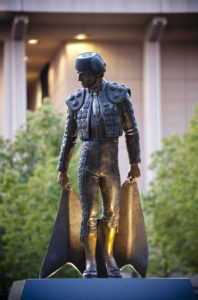
The Matador Statue
(Photograph by Lee Choo)
In 2000, CSUN introduced the first Central American Studies program in the nation. December of that same year marked the restoration and relocation of the campus carillon to Cypress Hall after it was damaged in the 1994 earthquake. In 2001, with President Blenda Wilson stepping down to run the Nellie Mae Education Foundation in New England, CSUN welcomed its fourth president, Dr. Jolene Koester. In 2003, the College of Education was renamed the Michael D. Eisner College of Education, honoring the then-Walt Disney Company chairman following the Eisner Foundation’s $7 million gift to establish the Center for Teaching and Learning in the College. Later that year, the Abbott and Linda Brown Western Center for Adaptive Aquatic Therapy opened as an extension of the campus’s existing therapy programs.
In 2004, CSUN partnered with the Los Angeles Unified School District to open Northridge Academy High School (NAHS). Located on CSUN’s North Campus, NAHS was the district’s first new comprehensive high school in more than 30 years. In 2006, alumnus and former California Lieutenant Governor Mike Curb pledged $10 million to the University in support of the College of Arts, Media, and Communication, in addition to the campus’s future regional performing arts center. In honor of this generous gift, the College was renamed the Mike Curb College of Arts, Media, and Communication.
In 2007, the University dedicated a 1-megawatt fuel cell power plant as part of the campus’s continuing effort to provide clean energy. The plant, one of the largest at any university in the world, provides 15 percent of the energy consumed on campus. In 2009, CSUN founded the Institute for Sustainability, which works to integrate sustainability into all aspects of the University. The year 2009 also marked the 50th anniversary of CSUN’s founding and was commemorated with a fundraiser to construct the Matador Statue, originally conceptualized in 1989. Unveiled in 2011 across from Matador Square, the nine-foot bronze statue was created by North Carolina sculptor Jon Hair and serves as the centerpiece for the ongoing Tradition of the Rose.
2010s—A Focus on Sustainability
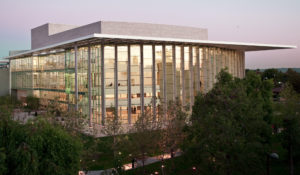
Valley Performing Arts Center (Photograph by Lee Choo)
The grand opening for the 1,700-seat LEED-Certified Valley Performing Arts Center (VPAC), held on January 29, 2011, was attended by celebrities, city and county leaders, alumni and the local community. The debut concert incorporated a variety of genres, reflecting the VPAC’s diverse performance program aimed at students, alumni and the greater Los Angeles area. In July 2017, the VPAC was renamed the Younes and Soraya Nazarian Center for the Performing Arts (“The Soraya”) in recognition of a $17-million gift from the Y&S Nazarian Family Foundation. This historic gift is the CSU’s largest single gift to the arts and one of the largest in Los Angeles arts history.
In 2012, CSUN welcomed Dr. Dianne Harrison as the fifth and current president of the University. That same year, three major additions were made to the University Student Union: the Veterans Resource Center, the Pride Center, and the LEED-Certified Student Recreation Center (SRC), the last of which replaced the Fitness Centre. The SRC has received several awards for environmental design, including the 2013 American Institute of Architects (AIA) Education Facility Design Award for balancing function, form and sustainability.
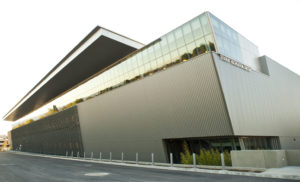
Student Recreation Center (Photograph by Lee Choo)
In 2014, CSUN collaborated with the Los Angeles Cleantech Incubator to form the LACI@CSUN business incubator with the goal of helping startup companies from CSUN and the San Fernando Valley achieve their full potential. That same year, alumnus David Nazarian pledged to fundraise $25 million for the University, inaugurated by his $10 million gift. In recognition of Nazarian’s gift and commitment to raise funds for the University, CSUN renamed its College of Business and Economics the David Nazarian College of Business and Economics. The fundraising goal was realized in 2016, the same year that marked the College’s 50th anniversary.
In 2015, CSUN continued to expand its commitment to environmental and student wellness. In February 2015, CSUN received recognition as a Tree Campus USA university, acknowledging college and university campuses that effectively manage trees and engage students in awareness and conservation efforts. In August 2015, with strong support from the campus community, CSUN launched its “Clear the Air” initiative, which established the campus as a smoke- and tobacco-free zone. During this same month, the Oasis Wellness Center opened, providing students and staff a location dedicated to managing and reducing stress.
In October 2015, President Harrison joined a group of 10 university presidents in signing a pact as part of the American College and University Presidents’ Climate Commitment (ACUPCC). Under the pact, and in partnership with the organization Second Nature, the campuses are committed to goals that include carbon neutrality and climate resilience. CSUN has established the goal of becoming carbon neutral by the year 2040. The University’s continuing commitment to sustainability was formally recognized in February 2016, when the Association for the Advancement of Sustainability in Higher Education (AASHE) awarded CSUN a gold rating under the Sustainability Tracking, Assessment & Rating System (STARS), the highest rating awarded in the CSU system.

Extended University Commons (Photograph by Lee Choo)
Construction of the University’s newest building, the LEED-Certified Extended University Commons, was completed in summer 2016. Primarily housing the Tseng College, the building also provides space for the academic advising office for new international students. In September of that same year, the CSUN Food Pantry opened as an extension of the CSU Cares initiative. The pantry provides cost-free resources to students experiencing food insecurity.
In February 2017, the groundbreaking ceremony for the new Research Building was held. The building will initially house the newly formed Material Sciences and Health Disparities research groups, and over time will expand to serve additional research purposes. In April 2017, CSUNSat1, a cube-shaped satellite designed, built and tested by CSUN students and faculty in a collaboration with Jet Propulsion Laboratory (JPL), launched into space from Cape Canaveral Air Force Station. The satellite, developed to test a low-temperature capable battery and ultra-capacitor power system, was deployed into low earth orbit from the International Space Station in May 2017. A ground station located at CSUN communicates with the satellite to run experiments and send the resulting data down to Earth. The Associated Students Sustainability Center, the first in the CSU system, opened in October 2017, furthering CSUN’s commitment to become an ever-more environmentally friendly and sustainable campus. The Center, the University’s first net-zero energy building, serves as an expanded collections station for campus recyclables, the administrative hub of AS sustainability programs and services, and as the administrative offices of the Institute for Sustainability.







